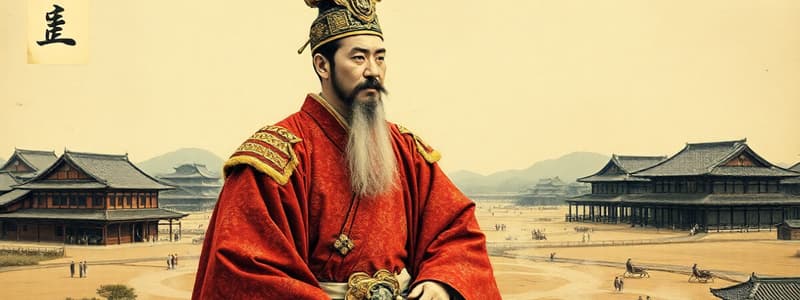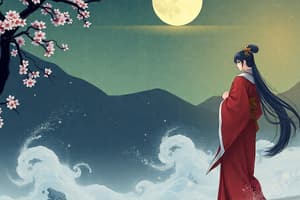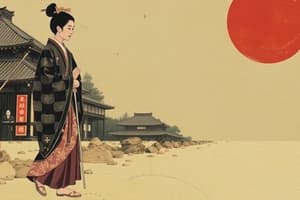Podcast
Questions and Answers
The Heian period is characterized by a significant shift in Japanese culture. Which of the following best describes this transition?
The Heian period is characterized by a significant shift in Japanese culture. Which of the following best describes this transition?
- A move towards establishing a unique Japanese identity distinct from Chinese models. (correct)
- A renewed focus on Chinese traditions and governance after a period of isolation.
- A rejection of all foreign influences and a complete return to ancient Japanese practices.
- An expansion of Chinese cultural influence across Japan through imperial decrees.
Emperor Kanmu's decision to relocate the capital to Heian Kyo (Kyoto) in 794 CE was primarily intended to:
Emperor Kanmu's decision to relocate the capital to Heian Kyo (Kyoto) in 794 CE was primarily intended to:
- Increase trade relations with China by establishing a port city.
- Escape frequent natural disasters that plagued the Nara region.
- Create a capital that was closer to the ancestral lands of the Imperial family.
- Consolidate imperial power and move away from the strong Buddhist influence in Nara. (correct)
The Fujiwara clan's dominance during the Heian period was largely attributed to their strategic use of:
The Fujiwara clan's dominance during the Heian period was largely attributed to their strategic use of:
- Economic control over key industries and trade routes.
- Military prowess and territorial expansion.
- Marital alliances with the imperial family and influence over imperial heirs. (correct)
- Religious authority derived from their claimed divine ancestry.
Which of the following cultural developments during the Heian period MOST directly empowered women of the aristocracy?
Which of the following cultural developments during the Heian period MOST directly empowered women of the aristocracy?
The flourishing of aristocratic culture during the Heian period, marked by a focus on beauty and refinement, was MOST directly supported by:
The flourishing of aristocratic culture during the Heian period, marked by a focus on beauty and refinement, was MOST directly supported by:
The development of Hiragana script in Heian Japan is MOST directly attributed to which cultural practice?
The development of Hiragana script in Heian Japan is MOST directly attributed to which cultural practice?
Lady Murasaki Shikibu's 'The Tale of Genji' is considered a significant literary work for which primary reason?
Lady Murasaki Shikibu's 'The Tale of Genji' is considered a significant literary work for which primary reason?
Yamato-e painting during the Heian period is BEST characterized by its:
Yamato-e painting during the Heian period is BEST characterized by its:
The rise in popularity of Pure Land Buddhism during the late Heian period is MOST likely attributed to:
The rise in popularity of Pure Land Buddhism during the late Heian period is MOST likely attributed to:
Heian society's intense focus on physical beauty, as evidenced by practices like face powdering and teeth blackening, suggests that:
Heian society's intense focus on physical beauty, as evidenced by practices like face powdering and teeth blackening, suggests that:
Flashcards
Heian Period
Heian Period
A period in Japanese history from 794 to 1185, marked by cultural flourishing and a move away from Chinese influence.
Emperor Kanmu
Emperor Kanmu
Moved the capital to Heian Kyo (modern-day Kyoto) in 794, initiating the Heian period.
Nara
Nara
The prior capital city to Heian Kyo(Kyoto); it was modeled after the Chinese capital Chang'an during the Tang dynasty.
Fujiwara Clan
Fujiwara Clan
Signup and view all the flashcards
Sosho
Sosho
Signup and view all the flashcards
Hiragana
Hiragana
Signup and view all the flashcards
Yamato-e
Yamato-e
Signup and view all the flashcards
Tendai Buddhism
Tendai Buddhism
Signup and view all the flashcards
Kosode
Kosode
Signup and view all the flashcards
Hogen Disturbance (1156)
Hogen Disturbance (1156)
Signup and view all the flashcards
Study Notes
- The Heian era in Japan, lasting from 794 to 1185, marks a period of cultural renaissance.
- During this time, Japan began to forge its own identity, moving away from Chinese influences that had been prominent in earlier periods.
- Everything distinctively Japanese can be traced back to the Heian Period.
Emperor Kanmu and the Shift from Nara
- Emperor Kanmu initiated a period of self-discovery and tranquility following the Nara period (710–784).
- The capital was moved to Heian Kyo (modern-day Kyoto) in 794, which started the Heian period.
- The move away from Nara signified a departure from the centralized government modeled after China's Tang dynasty.
Characteristics of the Era
- The Heian period was characterized by the refinement of Japanese culture and aesthetics.
- Aristocratic culture flourished, significantly influenced by the Fujiwara clan.
- The Empire's wealth and power led to a focus on beauty and the finer things in life.
- The era saw the emergence of uniquely Japanese cultural elements like the kimono, the Hiragana writing system, modern fiction, and specific beauty standards.
The Fujiwara Clan and Aristocratic Influence
- The Fujiwara clan dominated the Heian period and rose to power by marrying their daughters into the imperial dynasty.
- This gave them influence over future emperors, as the mother's side of the family traditionally raised the children.
- Maternal traditions, therefore, shaped the culture from the Fujiwara's perspective.
- Noblewomen were well-educated and involved in the arts because they were responsible for their children's education.
- Women used a Japanese kana script known as sosho, which led to the development of Hiragana.
Literary and Artistic Contributions
- Heian noblewomen made significant contributions to literature using sosho.
- Lady Murasaki Shikibu's "The Tale of Genji" is often regarded as the world's first novel.
- "The Tale of Genji" presented an in-depth depiction of Heian everyday life and ideals.
- Yamato-e, a narrative painting style, emerged to complement literature, characterized by continuous drawings often done on lengthy scrolls.
Religious Developments
- The Heian era saw the emergence of aristocratic sects of Buddhism, Tendai and Shingon.
- The monk Saicho introduced Tendai, the Japanese equivalent of China's Tiantai school that was based on the Lotus Sutra.
- The belief that all beings can acquire enlightenment was a central pillar of Tendai theology.
- The monk Kukai introduced Shingon, Japan's version of China's Zhenyen school of Vajrayana Buddhism.
- Shingon's popularity grew due to its emphasis on symbols, rituals, incantations, and mandalas.
- Pure Land Buddhism gained followers among the masses by promising enlightenment and rebirth.
Beauty Standards and Fashion
- People during the Heian era were obsessed with beauty, prioritizing appearance.
- Features such as black hair, delicate mouths, and light complexions were considered desirable.
- Both men and women powdered their faces and blackened their teeth.
- Men groomed thin mustaches and goatees while women drew thin, highly arched eyebrows and small, red lips.
- Fashion became a form of expression; the juunihitoe, or twelve-layered robe, emerged.
- The kosode, a silk robe undergarment worn by both men and women, evolved from the juunihitoe and is the direct predecessor of the kimono.
Timeline of Key Events
- 794: Emperor Kammu relocated Japan's capital to Heiankyo (modern-day Kyoto).
- 806: Monk Saicho established the Tendai Lotus School.
- 816: Monk Kukai founded the Koyasan Kongobu-ji Temple (Shingon sect).
- Early 900s: Aristocratic women began wearing the Junihitoe.
- 1008: Murasaki Shikibu wrote "The Tale of Genji".
- 1052: Fujiwara no Yorimichi converted a villa into the Byodo-in Pure Land Buddhist temple.
- 1156: Hogen Disturbance and rise of the Taira clan.
- 1159: Heiji Disturbance and the end of the Fujiwara's dominance.
- 1180-1185: The Genpai War ended with the defeat of the Taira armies and the rise of the warrior class under Minamoto no Yoritomo.
- 1192: Emperor Go-Shirakawa appointed Minamoto no Yoritomo as shogun.
Decline and Influence on Modern Japan
- The Hogen Disturbance of 1156 marked the beginning of the end of the Heian Period.
- Conflict between former emperor Sutoku and Emperor Go-Shirakawa led to the rise of the Taira clan.
- The Heiji Disturbance further weakened the Fujiwara family, leading to the rise of the warrior class.
- The Genpai War resulted in the ascent of the Minamoto and the defeat of the Taira clan.
- The appointment of Minamoto no Yoritomo as shogun by Emperor Go-Shirakawa began Japan's feudal period.
Studying That Suits You
Use AI to generate personalized quizzes and flashcards to suit your learning preferences.
Description
The Heian era (794-1185) in Japan fostered a unique cultural identity, shifting away from Chinese influences. Emperor Kanmu's move to Heian Kyo (Kyoto) marked the start of this period. Aristocratic culture flourished with a focus on beauty.




